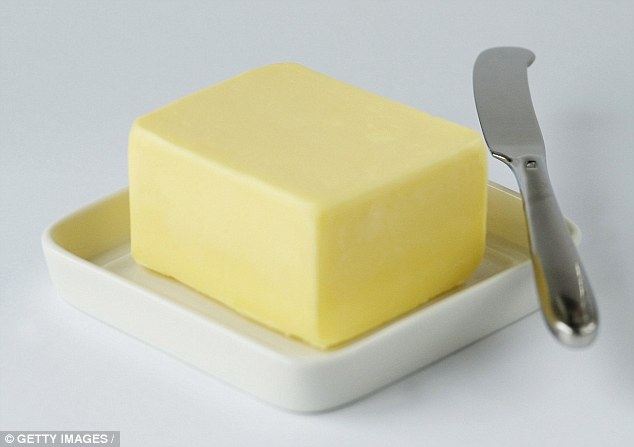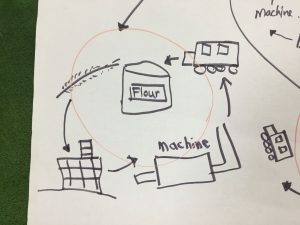How the World Works
The things we use come from somewhere else.
Form, Causation, Connection
Changes of State, Production
-
the process of how and why things change (Changes of state, Causation)
-
the form of materials changes according to intended use (Form)
-
how we get resources (Connection)
Story#1
Musical Instruments
Ms. Heidi brought in some musical instruments. They were made of different materials. The students sorted out the materials into 3 groups. 
- Metal
- Plastic
- Wood
 Next, the students cut, sorted and glued pictures into the different groups.
Next, the students cut, sorted and glued pictures into the different groups.

A group of students went on a hunt to look for items made out of the different materials.
https://twitter.com/NISPreKK1/status/925200553734320128
The students then sorted out the photographs they had taken on their journey. They all looked for items in the classroom that were made out of the same materials and put them into the groups. They labelled their groups.


SLO’s
- develop an inquiring mind
- ask questions about things in the classroom, places & people at school
- collect objects related to their study
- sort and classify objects into categories by attributes (Similarities & Differences)
- use inquiry to acquire information
- make statements that reflect their understandings
- participate in communal classroom activities
- listen to others
- name things in the classroom, places and people at school
- make observations about their immediate environment
- interpret and analyse visuals and multimedia to gain understanding
- communicate information using pictures and simple posters
- sort real objects into sets by one common attribute using own and others’ criteria
- explain criteria for sorting
- be able to explain data using simple language such as same and different/more or less/most or least
Story#2
Baking Bread
The students listened to the story of ‘The Little Red Hen‘ retold by storyteller Grethe Mangala Jensen. 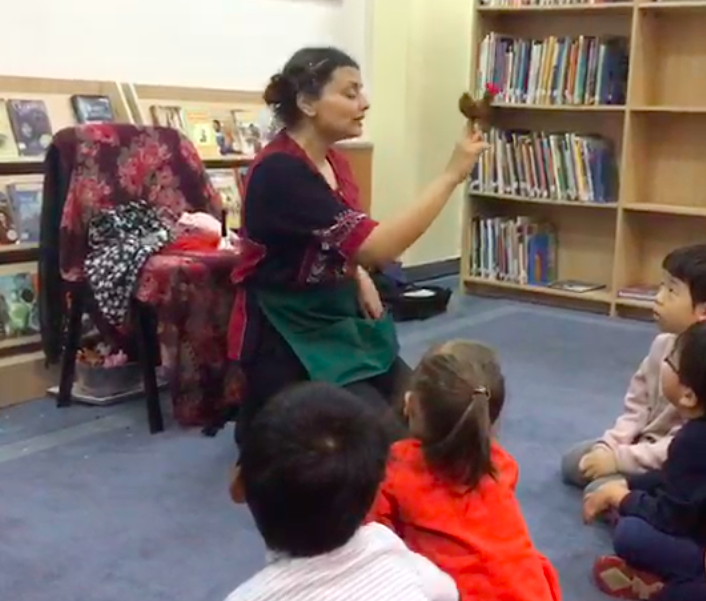
Can we become storytellers?
The students watched the puppet story ‘The Little Red Hen’.
They made puppets to retell their own version of ‘The Little Red Hen’.
Can we bake our own bread?
Ms. Angie helped the children follow a recipe to bake the bread. They discussed the ingredients, measured quantities and helped knead the dough. The students shared the bread with the whole grade.
https://twitter.com/NISPreKK1/status/928925466307657728
SLO’s
- measure quantities
- follow a sequence of steps
- learn to take turns
- co-operate and share in mixed groups
Story#3
 “How are things made?”
“How are things made?”
- Reggie “Everything is made out of atoms. It is something that everything is made of. Even we are made out of atoms. You cannot see atoms. You need a detectives kit. Atoms are like tiny dots.”
- Cornelis “When you put things together.”
- Franz “I want to know how carpets are made. How are cars made?”
- Tyler “Yes, cars!”
- Reggie “I want to know how shoelaces are made. How are books made?”
- Ruby “I want to know how beds are made. How about diamonds!”
- Hannah “I want to know how tables are made. How are socks made?”
- Ruby “Socks are made of wool.”
- Cornelis “How are houses made? … They are made with bricks. You have to make it with a friend (referring to the houses made with blocks in the classroom).
Our inquiry continues…
Story#4

Fire!
I am making a fire there.
- Mia: Fire comes from the sticks [matchsticks]. I am drawing a fire and more colours because I like it.
- Teacher: What can you do when there is a fire?
- Mia: It can run away and then fire is not coming. If you touch it you can be hot. There will be no more babies.
- Teacher: Why?
- Mia: Because babies cannot running.
- Teacher: Have you seen a fire?
- Mia Yes! From Peppa Pig. This fire, and always fire in coming on trees, and rocks and all the things.
- Reggie: When did you make it?
- Mia: Today.
- Reggie: What is happening with the fire?
- Mia: The fire is in the sticks.
- Teacher: What else do we know about fires?
- Reggie: You can make them with rocks and sticks. That is how you make fires.
- Abby: I have seen fire for real. In Canada. I burned my finger.
- Ryan: Fire is big. Fire is red.
- Abby: Sometimes it’s blue.
- Reggie: Some fires are small. Once I put my finger through a candle. My finger will fall off. The fire is blue when you cook.
- Hannah: The fire is pointed at the top (in Chinese).
- Teacher: What will happen if we put something into the fire?
- Reggie: It will burn but metal won’t burn.
- Teacher: What will happen to the metal?
- Reggie: It would stay like it is normally.
- Hannah: It will get hot.
- Reggie: The plastic will melt but the metal won’t.
- Teacher: What about paper?
- Hannah: It will get hot.
- Reggie: And burn.
We wonder what will happen to different materials if they were put into the fire…
Story#5
Scissors
The students wondered how scissors were made and what would happen if scissors were put into the fire. This led to a discussion about what we know about scissors.

- Mia: Scissors cannot be put in the fire.
- Amber: You have to be careful when you use the scissors (in Mandarin).
- Teacher: Why?
- Amber: Because we might cut our finger.
- Ryan: Don’t put it in the water because it will break.
- Reggie: If you put the scissors in the water it will get rusty.
- Teacher: From where did we get the scissors.
The students agreed that the scissor was made with metal and plastic.
- Reggie: We ordered the scissors. We got it from a factory. They break down the metal and then they make a point bit and then they make 2 lines go off it and then they make 2 circles and then make the plastic go over it.
- Mia: Scissors cannot put in the fire.
- Reggie: They carve it and sometimes use sharp knives to sharpen it.
- Tyler: No put the car. The car engine will break [get stuck inside] the car.
- Abby: Don’t put it in your shoes. If we have no scissors then we can’t cut paper.
- Ryan: We are cutting paper and hair with scissors.
They wanted to test the scissors we have in the classroom. 
The students watched a video on how scissors are made.
Concepts: Form, Production
Story#6
Pancakes
Inquiring into the process of how and why things change (Changes of state, Causation)
Mia made a pancake with clay. The students shared their ideas about making pancakes. “They are made with eggs and milk” said one child, “We need flour too” said another. We decided to make our own pancakes. The students wondered what they could put as toppings. “Mmm…I like honey, jam, chocolate” said the students. We decided to ask Ms. Angie to help us make pancakes.
The next day Ms. Angie made pancakes with the students. They reflected on the process.
- Reggie “We are making pancakes!”
- Amber “I saw eggs.” [in Chinese]
- Mia “Me making pancakes, put two eggs in the bowl.”
- Franz “I mixed the flour because the flour needs to go in the bowl, so we can make pancakes.”
- Reggie “We did that so we won’t have lumps in the pancakes.”
- Mia “Make a hole in the flour to make the egg inside.”
- Reggie “It feels slimy.”
- Yusei “We had to crack the eggs.”
- Jasmine “I put milk in there.” [in Chinese]
- Franz “Ok, then it was my turn.”
While making the pancakes, the students took turns and discussed the process. They observed how the batter, a liquid changed while it cooked.
- Mia “We need to cook.”
- Reggie “It is easier to cook.”
- Abby “Butter sound like snake. [Referring to the sizzling sound the snake makes]
- Hannah “Because it is hot!” [Explaining why the butter moves] “She made 7 pancakes.”
- Abby “She lift them up because some parts are burning.”
- Reggie “She flipped them over.”
- Teacher “What did we eat it with?”
- Hannah “Strawberry jam.”
- Reggie “And honey. There are six kids, each has 2. 2,4,6,8,10,12” [Reggie counted in 2’s to 12.]
- Ruby “We washed our plates because they are dirty, so we needed to wash them after they are dirty.”
- Teacher “What can we make next?”
- Ruby “Maybe cupcakes?”
- Reggie “I can make cupcakes too!”
https://twitter.com/NISPreKK1/status/959022253458440194
Story#7
Snow!
It was a snow day!!!! The students played in the snow and collected large balls of snow to have a snowball fight!
 We read the story ‘The Snowy Day‘ by Ezra Jack Keats. The story captures the adventures of a little boy in the city on a very snowy day. He makes a snowball and puts it into his pocket…but then it melts!
We read the story ‘The Snowy Day‘ by Ezra Jack Keats. The story captures the adventures of a little boy in the city on a very snowy day. He makes a snowball and puts it into his pocket…but then it melts!
We decided to conduct our own experiments.
First, we collected three bags of snow.
https://www.youtube.com/watch?v=E3QfLF7aviQ
Reggie “We put snow in three bags to see which one melts.”
We placed one in the classroom. We observed it.
We put one in the freezer.
The last one we kept outside.
The bag in the classroom!
The bag in the freezer (F) The bag in the classroom (C) The bag outside (o)
- Cornelis “The snow bags got higher because the freezer was colder.”
- Mia “I am looking at the ice. We put it in the freezer.”
- Students “This one was outside it was not melting. It did not change.”
Some students were exploring how the icicles change to water and then how the water changes into different colours.
- Reggie “We put ice in the tub and waited for it to melt and then we mixed some colours like paint, and it kept changing colours and it turned yellow and red. Mine ended up purple.”
- Abby “Mine was brown. I made the brown the only colour.”
Story#8
Where did it come from?
We gathered to reflect on how we made pancakes with Ms. Angie.
Teacher “What did we need to make the pancakes?”
- Yusei “Flour.”
- Amber “Eggs.”
- Teacher “How many?”
- Amber “2.”
- Hannah “Milk.”
- Abby “Butter.”
- Reggie “Honey and jam.”
The students were asked where all the ingredients came from. Reggie replied, “From my house!” We continued to discuss the journey the ingredients had gone through to get to Reggie’s house.
- Cornelis “I know, it was in the supermarket! The milk comes from the cow.”
- Reggie “No the milk from the cow, and then the farm makes it into butter.”
Ryan suggested that Ms. Angie got it from “outside’. He pointed to the milk and butter and said “From farms. Strawberry jam from machines.”
The students pasted the pictures of the ingredients on a chart paper. They continued to share their ideas on the how the items came to be.
 The students pointed to the eggs.
The students pointed to the eggs.
Ryan “This is from chicken, farmer…chicken.”
Cornelis “Maybe it was from the chicken because they lay eggs. From the farm. The farmer lives in the farm. First you cut the egg and then it cracks.”
Abby “Inside the chicken’s body. They are in the farm. When the people go under him he gets it from the bottom. The truck gets it to the supermarket.”
 Cornelis “The honey, the bees suck up the honey and they take it to the hive and then they put it there. Then the queen lays lots of eggs and they hatch and then they become worker bees. Worker bees are the ones that collect all the honey.”
Cornelis “The honey, the bees suck up the honey and they take it to the hive and then they put it there. Then the queen lays lots of eggs and they hatch and then they become worker bees. Worker bees are the ones that collect all the honey.”
Ryan “This is farmer…bee.” [it is from the farm and the bees are in the farm]
Franz “It’s from the bees. It is from the leaves. Tree leaves. The bees get honey from the leaf.”
Abby “Honey comes from bees, no I think from the flower.”
From the children’s conversations, it was clear that they understood the important part the bee plays in gathering honey.
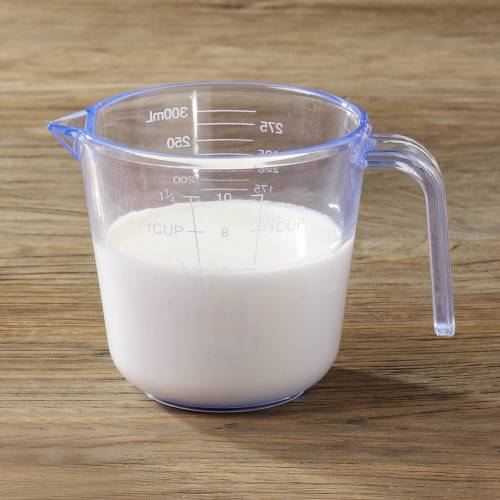 Ryan “I have in house. This is milk…I drink. This is farmer.”
Ryan “I have in house. This is milk…I drink. This is farmer.”
Abby “Milk comes from the cow. They take it from the truck.”
Franz “From the farmer because they have some cows. Then they take it out and then wash it and then drink it.” [referring to the cup that needs to be washed before you use it to drink milk]
Abby “This is butter.”
Franz wanted to draw an arrow from the milk to the butter he explained “Because you need to have milk to make butter. Because the farmer has the milk, then he can make the butter. He use the milk and flour to make butter.”
Cornelis “I know it was in the supermarket.”
Franz “We get it from the farmer, because the strawberries are in the farm. The farmer can make jam from the strawberries.”

Reggie “The flour gets out of the wheat and it gets into the machine.
He then drew the process…
- The wheat gets scrunched down.
- Then it comes into another machine. This machine mixes it up.
- Then it moves into a room and then the flour is put into a bag. And then it goes into another machine and it puts the bag into a big box.
- The box goes into a truck.
- Then it goes into the supermarket.
Next, we watched two videos. The first, the journey of milk and the second, how flour is made.
https://www.youtube.com/watch?v=RWPhne-ThL0
A group of students reflected on what they learned.
SLO’s
- make statements that reflect their understandings
- listen to others
- interpret and analyse visuals and multimedia to gain understanding
- communicate information using pictures and simple posters
Story#9
We have been exploring how the things we use come from somewhere else.
The students were sharing what they know about honey and bees.
- Franz “I saw that the bee is drinking honey from the flower.”
- Reggie “Bees make honey.”
- Mia “They eat the flower.”
- Ryan “The bee eats the honey.” [in Mandarin]
- Amber “The bear eats honey when he is hungry.” [in Mandarin]
Mia explained that Winnie the Pooh also likes to eat honey.
We watched a video about how honey is made.
Ryan explained that he eats a kind of ice cream with honey. Max added that he drinks ‘honey water’.
A group of students drew pictures to share their thinking.
Franz “Honey is made from bees and flowers. The bees drink in the flower honey… so the bees can drink it all the way so the farmer can take the honey away.”
Ryan thought hard about what he wanted to include in in his picture.
Mia “This is the bear and he waits till the bee goes away and then he eat it. The bee go away and the bear eats. The bees are coming to eat the flower.”
Franz “Look the bees is drinking honey so the bees take it to his friends so the bees can drink all the honey. Because the bees need to babies.” Franz explained that the bees need honey to feed the babies that are in the hive. He began to label his pictures using the sounds he hears in words.

Students used their real life experiences to extend their play.
https://twitter.com/NISPreKK1/status/1009314153448669186
Some students made cakes in the playground!
https://twitter.com/NISPreKK1/status/974918896682594304
Story#10
 Shall we bake a cake?
Shall we bake a cake?
A few weeks ago the students made pancakes with Ms. Angie. While reflecting on the activity, the students suggested that we “make cakes next time“.
We began by making a plan.
Teacher “What do you think we need, to make a cake.”
The students reflected on their previous experiences of cooking, when they baked bread and made pancakes.

The first ingredient mentioned was milk. The students began to explain the process of milk. We drew pictures to record our discussions. Arrows were used to help us follow the process.
 We continued to talk about what type of cake we wanted to make. The students all agreed that it had to be a chocolate cake. This led us to discuss our second ingredient, chocolate.
We continued to talk about what type of cake we wanted to make. The students all agreed that it had to be a chocolate cake. This led us to discuss our second ingredient, chocolate.
Franz “We need lots and lots of chocolate, because we can make lots of chocolate cake!”
We discussed where chocolate came from.
Franz “From the chocolate truck.”
We continued to talk about how the chocolate got to the chocolate truck. How did it get there? Where did it come from? The students explained that it came from the chocolate factory.
Cornelis explained that they go through many different machines in the factory. We continued to include our thoughts on the plan.
The next ingredient on the list was ‘flour‘. The students used the information they gathered when watching the video on how wheat is turned into flour. Again, this process was documented.
The students suggested that we would probably need eggs. They explained that this would come from a farm or a factory. The students explained that in a factory the eggs are put in trays to ensure that they don’t break.
 Cornelis chose to draw his own picture of this process. He used his knowledge of letter sounds to include labels in his picture.
Cornelis chose to draw his own picture of this process. He used his knowledge of letter sounds to include labels in his picture. 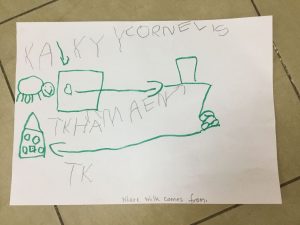
https://twitter.com/NISPreKK1/status/962179867977572353
We still had one more decision to make. What shape would our cake need to be?
The shapes suggested were:
- square
- circle
- triangle
- rectangle
- cupcakes
There were clearly too many choices. We had to take a vote. 
By popular vote, we plan to make chocolate cupcakes! The plan will be presented to Ms. Angie.
We look forward to putting our plan into action!
SLO’s
- reflect on past experiences
- make a plan
- sequence events
- communicate understanding through drawings and words
- explain a process
- question to find out more
- listen to others
- build on others’ ideas
Story#11
Cupcakes!!
About a month ago, the students shared their knowledge about baking. They discussed how to make a cake. The decided to make a plan:
- Mia “We are making a cake.”
- Abby “A chocolate cake!”
Ms. Angie helped us reflect on what we knew about the ingredients. Where they came from and the process they go through.
- Reggie “Flour comes from wheat.”
- Franz “Eggs come from chickens, and the chickens lay some eggs.”
We wondered about butter. Where does it come from?
- Reggie “It comes from milk.”
We wondered why it did not look like milk.
- Kai “Yeah, but it’s made from milk. You have to put it inside and then melt it.”
We wondered about sugar. Some students suggested that it came from butter.
- Reggie “No, it doesn’t. It comes from sugarcane.”
We noticed the bowl of coco powder.
- Cornelis “Chocolate, you have to melt it.”
We wondered why it did not look like the chocolates we usually see.
- Abby “Coco powder comes from coconut!”
Next, we shared what we know about the items we need to make a cake. A whisk, a sieve.
- Franz “We need the holes because we are putting the flower.
- Ruby “because you have to shake it out into the bowl.
- Reggie “So there are no lumps.”
We began to make the cake. First, we sifted the flour.
Then we creamed the butter by mixing the butter and the sugar.
- Hannah “Then we cracked the eggs.”
- Mia “Because we need eggs, because then we can make a cake.”
- Kai “Then we used a spoon to crack the eggs.”
- Cornelis “Because when you pinch the egg then we have to crack it or it will spill on the floor.”
- Tyler “This is chocolate.”
- Ryan “Because chocolate cakes.”
- Franz “A chocolate cake needs chocolate.”
- Cornelis “I think he is mixing it.”
- Reggie “So when it goes in the cakes there is no lumps.”

- Abby “Stirring chocolate with eggs.”
- Cornelis “Then we put it into a cupcake pan.”
- Amber “So yummy!”
- Kai “And we put the chocolate in.”
- Hannah “We put it in our fingers and it was yum.”

- Reggie “We put it in the tray because when it is baking it won’t wobble or tip over onto the other side.”
- Amber “Hold slowly.”
- Cornelis “It won’t go crazy in the oven.”

The Cupcakes!!!!!!!
The students decorated the cupcakes and shared them with their friends in both classes.
https://twitter.com/NISPreKK1/status/972021700136087552
The students drew the process. Here are a few examples.
SLO’s
- reflect on past experiences
- make a plan
- sequence events
- communicate understanding through drawings and words
- explain a process
- question to find out more
- listen to others
- build on others’ ideas
Story#12
Carrots!
K1A came in with invitations written in Chinese and English. They wanted to present us with the information they had collected during their research into ‘carrots‘.
We decided to reflect on what we already know about carrots.
- Ruby “I like to eat it. They come from the vegetable shop.”
- Lawrence [in Mandarin] “I saw carrots in a rectangle shape.”
- Reggie “I like to eat carrots. They let you see in the dark.”
- Alejandra [in Mandarin] “I like carrots.”
- Amber [in Mandarin] “The carrots are like triangles. I like this one the best. My mum always fries the carrots.”
- Ryan “The carrots look like rectangle shape. The front of it looks like a triangle.”
- Cornelis “When the bunnies eat the carrots, they like to eat it most. The farmer feeds them. They like to eat it really fast. And then when it rains…”
- Kai “…it will come on top of the carrots! I love them. I always eat them because I like them. Carrots come from the garden. You have to grow it with a seed.”
- Michelle [in Mandarin] “Carrots, I eat all of them. They are orange. They come from the bowl we are eating.”
- Yusei “Orange.”
- Tyler [in Mandarin] “I like to eat the carrots. It tastes sweet. It is very healthy. You can grow up when you eat lots of carrots.”
- Franz “I like to eat carrots because carrots are orange. The carrots are long and the rocks are big. They grow in the sand.”
- Jasmine [in Mandarin] “I like to eat carrots because it is healthy. I share it with my big sister.”
- Mia “Carrots are good, because I like to eat carrots. It is my favourite.”
- Hannah “I like to eat carrots because carrots are yummy.”
What do you know about carrots?
Soup!
The students have been growing vegetables in the class garden plot. It was time to harvest the vegetables. Ms. May helped the students make soup with the vegetables from the plot.
https://twitter.com/NISPreKK1/status/977110533097664512
Story#13
Making Strawberry Jam
We went on a trip to a strawberry farm.
We picked many juicy ripe strawberries. Our baskets were full!
We brought the strawberries back to school. Ms. Angie helped us make strawberry jam!
- Mia “我们可以做草莓酱。(We can make strawberry jam.)”
- Lawrence “太脏了。(It’s too dirty.)”
- Ruby “It looks like yucky strawberry.”
- Lawrence “Ms. Hannah, 为什么我的草莓不粘了? (Why isn’t my strawberry sticky?)”
- Reggie “ We need to mix around and squash it.”
- Tyler “我觉得这个饮料会很好喝。(I think this drink will be very delicious. )”
- Mia “看这个叉。(Look at this fork.)”
- Hannah “看我的叉叉,我先压,然后你再压。(Look at my fork, I press first, and then you press.)”
- Mia “我们是医生,医生就是这样做的,护士也来帮忙。 (We are the doctors, the doctors do it this way, and nurse help too.)”
- Hannah “Mia, 不要压在我的叉子上。 (Mia, don’t press on my fork.)”
- Ryan “Look at mine! It’s so hard.”
- Hannah looked at Mia and said… “Mia,你要把手放在碗上,这个碗就不会倒了。(Mia, you need to put your hand on the bowl, so the bowl wont tip over.)”
- Lawrence “看我们草莓有多脏吗? (Look how dirty our strawberry is!)”
Mia saw one child eat the mashed strawberry from the table, so she told him not to eat it.
- Mia “ 吃生的草莓会生病的。 (Eating the raw strawberry will make you sick.)”
- Alejandra “我们的太少了,我们要多一点。 (We have too little, and we need a bit more.)”
- Cornelis “We need to mix it really fast.”
- Amber says to Yusei “Fast Yusei! Go fast!”
- Cornelis “This is amazing, right Abby?”
- Abby “Right.”
- Cornelis “We will make strawberry jam, and we will put it in the oven.”
https://twitter.com/NISPreKK1/status/992332284631040000
The students then make scones to eat with the jam!
https://twitter.com/NISPreKK1/status/992333946867273728
SLO’s
- reflect on past experiences
- make a plan
- sequence events
- explain a process
- question to find out more
- listen to others
- build on others’ ideas
































